VB-9 strikes Rabaul
On November 1, 1943, American forces landed on Cape Torokina at Bougainville. That night, the Navy fought the Battle of Empress Augusta Bay, which stopped a Japanese force of heavy cruisers from disrupting the invasion and forced them to retreat to Rabaul. November 2 was spent defending the landing beaches from strong Japanese air attacks. The Americans had held off the Japanese fleet, but only narrowly. On November 3, Admiral Halsey learned from a reconnaissance flight that four more cruisers and several more destroyers had arrived at Rabaul from Truk to reinforce the Eighth Fleet and renew the attack on the Allied forces. Lacking the forces to successfully oppose this fleet if it attacked, Halsey requested emergency help from Admiral Nimitz at Pearl Harbor, later stating that the threat the Japanese cruiser force at Rabaul posed to the Bougainville invasion was "the most desperate emergency that confronted me in my entire time as ComSoPac."
The Central Pacific Fleet was already committed to the coming invasion of the Gilbert Islands later in November, but Admiral Nimitz managed to release Task Group 50.3, composed of Essex (CV-9), USS Bunker Hill (CV-17) and Independence (CVL-22), commanded by Rear Admiral Alfred E. Montgomery. The carriers departed Pearl Harbor on 3 November, headed for New Caledonia at flank speed.
The only carrier force immediately at hand in the South Pacific was Task Force 38, which had provided air cover for the invasion. TF 38 was centered around the veteran USS Saratoga (CV-3)and USS Princeton (CVL-23), commanded by Rear Admiral Frederick C. Sherman, captain of the first Lexington at the Battle of the Coral Sea. Saratoga and Princeton were refueling near Rennell Island the evening of 4 November when Sherman received the order to strike Rabaul. Other than the surprise raid at Pearl Harbor, no successful attack against such a well-defended land target had ever been made by carrier aircraft. The mission was considered highly dangerous for the aircrews and placed the carriers themselves at risk, but the fate of the invasion hung in the balance.
Sherman raced north at 27 knots. Task Force 38 arrived at the designated launch point 57 miles northwest of Cape Torokina at 0900 hours on November 5. The weather was favorable, with enough wind for easy launching and enough cloud cover to confuse the Japanese snoopers that spotted the force into believing only cruisers were present. All 97 aircraft aboard the two carriers - 52 F6F-3 Hellcats from Saratoga's VF-12 and Princeton's VF-23 , 23 TBF-1C Avengers from both carriers, and 22 Saratoga SBD-5 Dauntlesses of VB-12 - were launched while two land-based fighter squadrons from Barakoma and Vella Lavella arrived overhead to provide cover.
The strike achieved almost complete surprise, which was fortunate, as over 150 aircraft were based at Rabaul. A combat air patrol of 70 A6M Zeros met the strike, but the defenders expected the Americans to split up before attacking. By the time the Japanese realized the Americans were holding formation right through the heavy flak, it was too late to intercept effectively. The ships in the harbor were unprepared and vulnerable. In spite of the heavy antiaircraft fire and waiting fighters, the Americans lost only five Hellcats and five Dauntlesses.
The attack was followed an hour later by a Fifth Air Force raid from New Guinea composed of 27 B-24 Liberators escorted by 58 P-38s. As a result of the two attacks, six of the seven Japanese cruisers in Simpson Harbor were damaged, four heavily by the Navy. Atago was near missed by three 1,600-lb bombs that caused severe damage and killed 22, including her captain. Maya was hit by one bomb above an engine room that caused heavy damage and killed 70. Mogami was hit by one 500-lb bomb and set afire with heavy damage and 19 dead. Takao was hit by two 500-lb bombs that caused heavy damage and killed 23. Chikuma was slightly damaged by several near-misses. In the aftermath of the attack, Admiral Koga was forced to order the damaged cruisers back to Truk for repair. The attacks ended the Japanese warship threat to the Allied landing forces at Bougainville.
That night, Halsey sent a message to Sherman: "My utmost admiration for your brilliant performance during recent operations. Your strike was another shot heard round the world. When the Saratoga is given a chance, she is deadly."
After three days at sea on a high-speed run, Task Group 50.3 dropped anchor at Espiritu Santo in the Hebrides Islands south of Guadalcanal in the early evening of 5 November, where they learned of the strike against Rabaul that day by Saratoga and Princeton. The next day, the aircrews learned they would make a second strike against Rabaul. VF-9's "Mac" McWhorter remembered, "We were very concerned when we heard we were going there. They lost ten or eleven airplanes in that strike. We were told we could expect to find 80-90 Zekes there. What no one knew was the Japanese had flown in all the Zekes from their carriers at Truk down to Rabaul the day after that raid. When we got there, we were up against approximately 160 Zekes." Aboard Essex, the ship's newspaper "The Buccanneer" ran a cartoon of the announcement of Rabaul as target being made, followed by the entire crew jumping overboard.
At dawn on November 11, 1943, Sherman's Task Force 38 was operating under cover of a weather front near Green Island when they launched a dawn strike of 55 Hellcats, 25 Avengers and 21 Dauntlesses that had to contend with clouds most of the way, to discover that Simpson Harbor was almost completely cloud-covered. The bombers concentrated on three cruisers visible in the rain and hit one. 70 Zekes were up and chased the raiders in and out of the weather, but only caught seven; five of these returned to the carriers with battle damage while VF-12 scored one victory. After they recovered the strike, TF 38 retired to the south without being detected by the Japanese.
Essex, Bunker Hill and Independence were in the Solomon Sea 165 miles southeast of Rabaul when they launched their strikes at 0945 hours: 185 aircraft operating as separate groups from each carrier. The strike force included 16 SBD-5 Dauntlesses from Bombing Nine and 16 new SB2C-1 Helldivers of Bombing 17 on their combat debut, alongside TBF-1C Avengers from the three torpedo squadrons, escorted by Hellcats from the three carriers. McWhorter remembered, "We ran into trouble right from the start. En route to the target, we were at 12,000 feet when a dozen Zekes found us and tried to lure the fighters away, but we stuck with the mission." When the Essex strike arrived over Rabaul there were no Zekes in their vicinity, but the AA was very heavy.
Bunker Hill's Air Group 17 followed Essex's strike. VF-18, commanded by LCDR Sam L. Silber, stayed close to the bombers, but managed to score two Zekes. Independence's VF-22, supplemented by a 12 plane detachment from Fighting Six, scored four Zekes for three Hellcats. The six Zekes actually lost contrasted with American claims from the three squadrons for 30.
Overall, the strike was a success. The Japanese suffered one destroyer sunk, with another destroyer and light cruiser badly damaged, and three other ships slightly damaged, including the heavy cruiser Atago. The attacking squadrons lost only 11 aircraft.
Shortly after lunch, Essex's radar spotted an incoming raid 119 miles distant, which was following the returning planes from the morning strike. Pilots of VF-33 overhead reported “millions of them!” The Japanese had launched a strike of 67 Zekes, 27 Val dive bombers, 14 Kate torpedo bombers, and a few G4M1 Betty twin engine bombers. The strike was intercepted by the 12 Hellcats and 24 Corsairs defending the fleet. The Vals evaded the defending fighters but found the American antiaircraft accurate and deadly. No ships were hit, but Admiral Montgomery was compelled to cancel a second strike against Rabaul shortly after the launch began. Ensign C.T. Watts of VF-18 had only begun to retract his wheels from his launch when a Val appeared in front of him and he shot it down. Lt(jg) Rube Denoff of VF-9 had a similar experience when he was launched from Essex. “I didn't have time to even retract my wheels before I had a Val in front of me.” He shot it down, then connected with his wingman and proceeded to shoot down a Kate before he was hit by “friendly fire” from his carrier and forced to make an emergency landing aboard Essex. Radio control over the fleet broke down and the defending fighters found themselves flying toward flak bursts to engage the enemy.
American claims for 90 shot down in the attack were as excessive as the claims over Rabaul, but the Japanese lost eight Zekes and 31 Vals and Kates, despite some mistakes made by the American FDOs that resulted in 12 Hellcats being vectored to investigate a bogey that turned out to be 12 Hellcats from the second strike that had not been recalled.
When asked to compare the Rabaul strike with later events in his career as the first Hellcat Ace and a top-scoring Navy fighter pilot, McWhorter replied, "On a terror scale of 1-10, Rabaul was an 8. It was definitely my most memorable mission.
At the time of the strike, the name Rabaul struck fear in the hearts of American fliers throughout the South Pacific. Ninety days later, the base was abandoned to its fate by the survivors of the carrier air groups that had been sent to defend it after the greatest aerial campaign yet mounted by American forces in the Pacific War. The last of the prewar-trained IJNAF aircrew were lost there, and by the time the Battle of the Philippine Sea was fought four months later, the IJNAF ceased to exist as an organized threat. It's heart had been torn out and ground in the Rabaul meatgrinder.
The model here is the Accurate Miniatures SBD-5, which I found at the LHS "estate sale" with an asking price of $20. Since I can resist everything but temptation, the kit quickly found its way home with me and i was building a Dauntless for the first time in some 18 years. It's still as good as i remember. Everything you need is there, which is why since it first came out in 1994 there have never been any resin correction sets for the A-M SBDs. It's marked as one of the VB-9 Dauntlesses that made that strike on Rabaul in November 1943, using the Fundekals US National Insignia sheet and numbers from a sheet in the decal dungeon.
It's a great kit, it's not hard to create a real beauty. Academy has released a kit using the A-M molds with decals for SBD-5s flown in the Truk Raid in February 1944, the Central Pacific campaiggn against the bypassed islands in the Marshalls, and on the Mission Beyond Darkness at Philippine Sea. It's well worth having.
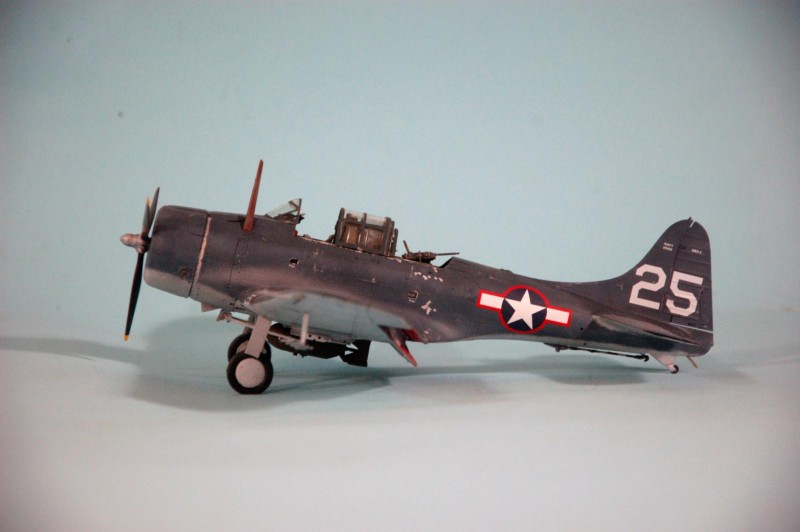
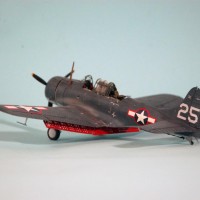
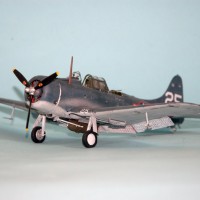
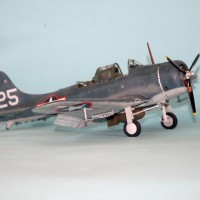
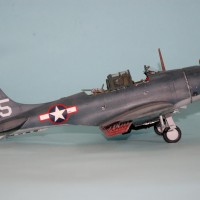
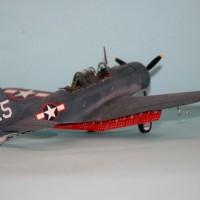

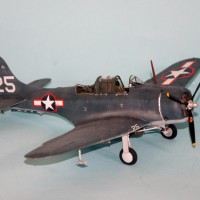
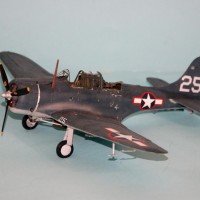

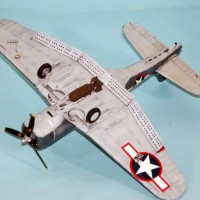
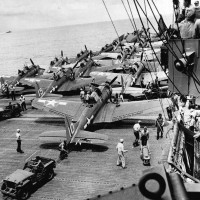
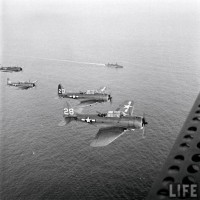
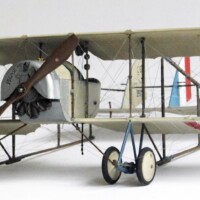
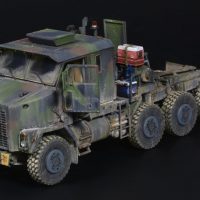
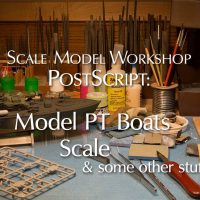
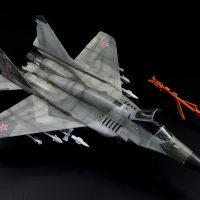
Great job done on a really good kit
It doesn't get any better than this build combined with this narrative. Thumbs up!
Hey, take care down there with the hurricane, "Florida Man"!
Another great build Tom, I love the History behind your builds, just fantastic.
Beautiful bird, Tom. Thanks for the history!
Nice build, Tom! The Dauntless is a favorite of mine!
Another superlative narrative and a great build. Funny that for a kit that’s been around for over 2 decades I never got my hands on one, guess I need to change that
Hello Tom,
Thanks for sharing your excellent model and the most interesting story with us. Interesting to see on the real picture, the Jeeps, being used as tow tractors on deck.
Regards, Dirk.
This is great build! I have the Academy 1/48 . Hope it will be as good as yours.
Commit to the radical act of following the instructions - it's a kit that wants to go together. One thing not mentioned in the instructions: DO NOT glue the lower wing part to the spar. Otherwise you will have a concave underside.
Thanks! Noted!
very nice history as always - I enjoy reading your write ups as much as looking at your builds. Always learn something new - thank you!
Great Tom! The Dauntless is my favorite USN WWII attack aircraft - just a classic look - newer lines than the Devastator and not the beast of the Avenger or Helldiver. Wonderful job on this one.
Super looking build and great story! The weathering on the SBD is very convincing.
beautiful...i've got an academy 5 and an AM 3 i need to get too
The nice thing is, the Academy kit has precut canopy masks for both the SBD-3/4 and SBD-5 canopies, so the one "drag" to building both kits is easy.
awesome info...didn't know that as the cellophane is still on both
Good looking build and nice write up!
Really nice finish on your Avenger. Looks suitably weathered and stained.
Sweet build -the touches of red add to it nicely.